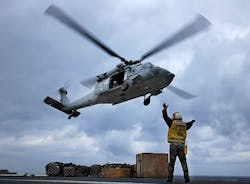Lockheed Martin to upgrade Terrain Awareness Warning System software on MH-60 ship-based helicopters
Officials of the Naval Air Systems Command at Patuxent River Naval Air Station, Md., announced an $8.9 million contract Tuesday to the Lockheed Martin Mission Systems & Training segment in Owego, N.Y., to make avionics software improvements in 2018 product line of the Navy MH-60.
Lockheed Martin engineers will make software modifications to implement the Terrain Awareness Warning System II (TAWS II) and Automatic Dependent Surveillance-Broadcast (ADS-B) aboard the 2018 MH-60 production run.
The MH-60R Seahawk and MH-60S Knighthawk are special Navy variants of the Sikorsky UH-60 utility helicopter. The MH-60R is for anti-submarine warfare (ASW) and other kinds of maritime warfare, and has a secondary search and rescue capability.
The MH-60S Knighthawk, meanwhile, is deployed aboard amphibious assault ships and fast combat supply ships for troop transport, vertical replenishment, and a secondary search-and-rescue role. The helicopter carries the ALQ-144 infrared jammer, and in the future will have the AQS-20A mine detection system and an airborne laser mine detection system (ALMDS) for identifying submerged threats in coastal waters.
The Terrain Awareness Warning System (TAWS) is an enhancement of the earlier Ground Proximity Warning System (GPWS) capability, and uses a digital terrain elevation database (DTED) and GPS to provide forward looking capability. This expands protection over all types of terrain, including rising terrain.
The TAWS II is a TAWS enhancement that provides obstacle-awareness capability for helicopters and other low-flying aircraft by using a DTED and vertical obstruction database (VOD).
The contract calls for Lockheed Martin to support government development and test, integration into the MH-60R/S mission computer (MC) and flight management computer (FMC), and MH-60R/S avionics operational program (AOP)/flight management program (FMP). This effort also includes updating MH-60R/S technical documentation, technical publications, and training materials.
Related: Navy looks to Exelis for avionics test systems for MH-60R and S-70B maritime helicopters
The Navy's MH-60R carries the latest version of the Light Airborne Multi-Purpose System (LAMPS) avionics suite, as well as the Aircraft Survival Equipment (ASE) package, the multi-spectral targeting system (MTS) forward-looking infrared sensor (MTS-FLIR), an advanced airborne fleet data link, and advanced airborne active sonar.
The MH-60R has a glass cockpit common to the MH-60S and other Seahawk versions, which substitute digital avionics displays for a complex collection of dials. The helicopter also has Mk-54 air-launched torpedoes and Hellfire missiles.
The contract announced this week calls for Lockheed Martin to support U.S. Navy MH-60 helicopters, as well as those of the governments of Australia and Denmark. Lockheed Martin will do the work in Owego, N.Y., and should be finished in October 2017.
For more information contact Lockheed Martin Mission Systems & Training online at www.lockheedmartin.com/us/mst, or Naval Air Systems Command at www.navair.navy.mil.
